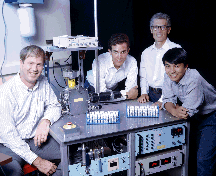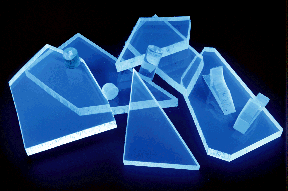


A DOCTOR SUSPECTS THAT HIS PATIENT HAS A BRAIN TUMOR but has been unable to confirm it. Rather than perform exploratory surgery, he prescribes a positron emission tomography (PET) scan. Administering a radioactive tracer to the patient, the doctor checks the condition of his patient's blood-brain barrier. The PET scan detects tracer in the brain, indicating that the barrier has been breached, probably by a tumor. Consequently, the doctor is able to locate the tumor and initiate treatment.
Over in the industrial sector, automotive engineers crank up an internal combustion engine built with experimental alloys designed to extend engine life. The parts under study have been implanted with a gamma-ray emitting radioisotope. As the engine runs, nearby detectors count the gamma-ray activity, registering the decline as a part wears away. Detecting engine wear as slight as one micrometer (.00005 inches), the technique reveals which ideas are headed for the assembly line and which are destined for the junkyard.
Far from the Earth, detectors on a satellite record telltale gamma rays emanating from a supernova, an exploded star. Scientists have theorized that as massive stars evolve, they produce an iron core which ultimately collapses and causes the star to explode, but they have lacked actual evidence. Data from the satellite detectors substantiate the theory.
Despite roles that range across the fields of medicine, science, and industry, these detectors are kin, related through a shared system of vision. In each case, their capacity to visualize is made possible through the marvel of scintillators.
Scintillation materials are a rarity in nature. They are distinguished by the way they interact with ionizing radiation. Ordinarily, materials transform ionizing energy into heat. Rather than radiate away all their energy as heat, scintillators transform some of this energy so that they glow with light.
Since 1903, when the effect was first discovered, about 20 useful scintillating materials have been discovered. Each has unique light-emitting properties which define and, ultimately, limit the usefulness of each substance.
At LBL, Life Sciences Division researchers Steve Derenzo and Bill Moses believe the potential of scintillators has just begun to be tapped. For the past five years, they have been prospecting for new scintillators. In particular, they are on the hunt for alternative inorganic scintillators, materials that glow when bombarded with gamma rays. To date, they have identified eight new compounds.

Bill Moses (left), Stephen Blankespoor, Steve Derenzo, and Matt Ho designed the tabletop pulsed-x-ray system
Derenzo and Moses are convinced that if human ingenuity is combined with new scintillators, scientists, doctors, and engineers will be able to see into worlds that currently are off-limits.
To cite one example, PET scans, which record biochemical activity in the body, are limited by the performance of available scintillators. PET medical images typically rely on bismuth germanate (BGO) scintillators. LBL's PET scanner, which has the highest resolution in the world, can record structures as small as 2.6 millimeters.
Derenzo and Moses believe they will be able to find scintillators that are perhaps five times brighter and emit light 10 times faster than those now available. This would double the resolution of spatial detail that the LBL instrument can achieve. Additionally, new medical tracers could be used, providing both sharper images and the ability to investigate additional disease processes. The researchers say comparable enhancements are feasible for other scintillator-based detectors.
Until Derenzo and Moses took on this mission, the search for better scintillators depended upon serendipity.
"Scintillator detectors use crystals," explains Derenzo. "Those of us interested in scintillators were always on the lookout for unusual crystal materials. We would wait for a crystal to fall into our lap and then test it. Unfortunately, relatively few compounds exist as natural crystals, so researchers would try to synthetically crystallize a compound. Millions of dollars and many years can be spent figuring out how to create these crystals. Then the moment of truth arrives: You test it and discover whether you have a new scintillator or a dud."
The element of surprise may be unavoidable. Almost every scintillator discovered seems to emit light through its own unique physical mechanisms. As of now, scientists cannot reliably predict what materials are going to be good scintillators. Despite this obstacle, the LBL researchers have devised a better way to look for the flash of scintillation.
"Our approach doesn't require crystal samples," said Moses. "We are able to use powders, which are more accessible. Tens of thousands of compounds can easily be formulated as powders. The range of materials that we can test is unprecedented."
A combination of properties determines the usefulness and limitations of a scintillator.
To begin with, gamma rays are highly penetrating, so the material must have stopping power. Otherwise, no interactions will occur that cause the material to emit light. To stop gamma rays, the scintillator material must be dense and have a relatively high atomic number. Alternatively, a thick section of material can be used, but this can be expensive. Worse, the thicker the material, the lower the resolution of the images produced by the scintillator detector.
Light output or brightness is a second critical quality. Derenzo and Moses are looking for materials that are relatively efficient at transforming ionizing energy into photons. The most efficient known inorganic scintillator, sodium iodide, emits 10 percent of the ionizing energy as light. Bismuth germanate, the material most commonly used to create PET scans, has an efficiency of only two percent.
Some materials are faster light-emitters than others. Generally, the shorter the time between the arrival of incoming gamma rays and the resultant flash, the less blurry the image.
Part Two of the Article: The Flash of Discovery